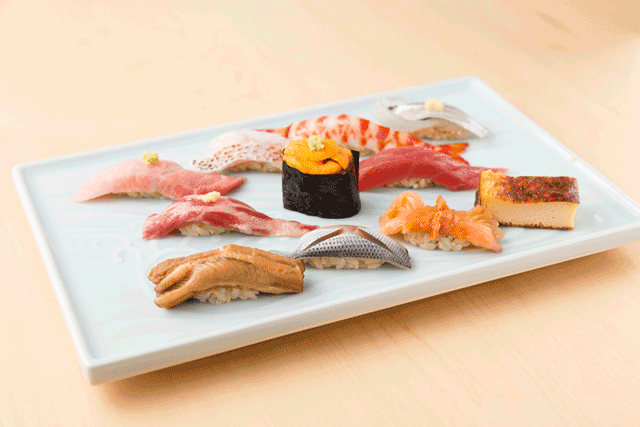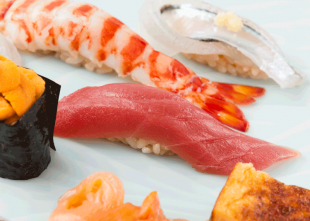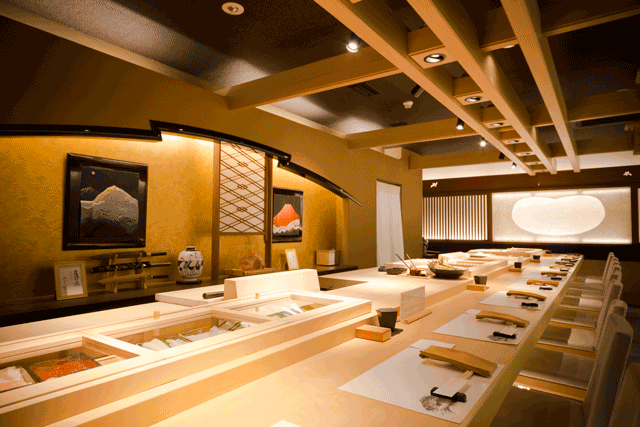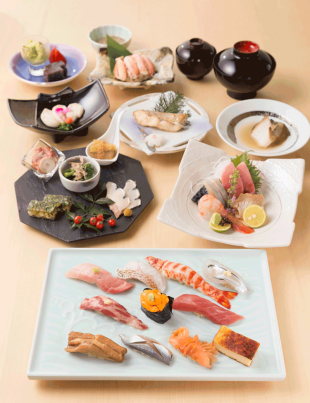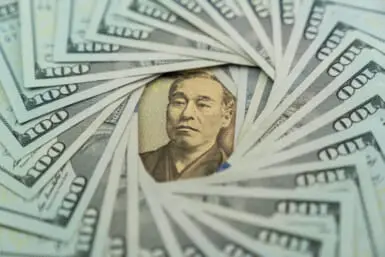A hidden gem in the heart of Ginza, Sushimasa combines sushi mastery with warm-hearted service.
Sponsored Post
Although sushi is one of the country’s most recognizable cultural and culinary exports, the delicacy that is now synonymous with Japanese food is, historically, a relatively new development. Before the Edo Period, nigiri-style sushi (that is, pieces of fresh fish, cut and served over rice) didn’t really exist. Earlier versions consisted of fermented or cured fish, and it was not until the late 19th century, which brought large numbers of laborers to Tokyo to work on construction projects. These workers needed quick food, and one variety was fish, freshly caught from the nearby Edo (now Tokyo) Bay. Sushi, as we know it, was born.
From these humble beginnings, sushi has become both a luxury item and a bite-sized example of Japanese craftsmanship. It’s a foodway that is closely linked to the country’s four seasons, and has a language all its own. Kanpachi (amberjack) is an autumn fish, while winter brings out the best in octopus; aji, or horse mackerel, has its finest flavor in summer, and tuna is excellent year-round. However, each fish must be prepared in a different way to complement its natural flavor and consistency, so it’s no secret that the process of becoming a sushi chef is one that takes years. A skilled practitioner of the “Way of Sushi” needs to know how to choose good fish, cut and season it properly, and mold it into the perfect shape.
A properly proportioned piece of sushi is a careful work of balance. The fish shouldn’t be too cold, or it will be difficult to appreciate its full flavor. A heaping amount of rice—something that can be found far too often overseas—is to be avoided as it, too, can mask the true taste. Even the way that the rice is shaped can add to the consistency and flavor of good sushi. Doctor of Medical Science (and food enthusiast) Uhei Naruse took a scientific approach to finding out the secret to good sushi, using an MRI to analyze pieces of sushi made by a veteran sushi chef, a trainee, and a robot. Naruse’s experiment showed him that the experienced chef’s piece was the lightest, and that there were considerable amounts of space among the grains of rice in his sushi. Finally, most of the grains in the sushi were pointing in the same direction (lengthwise), which helped the sushi hold together with the least amount of rice.
Even though this kind of highly refined skill is a central part of being a good sushi chef, Takeshi Doi, the store manager and head chef at Ginza Sushimasa, says that great technique is not enough. “Ude [arm, or skill] is very important, but the most crucial thing about preparing great sushi is here,” he says, while thumping the left side of his chest. “It’s your heart. It’s that feeling of omotenashi. The communication between customer and sushi chef is the most important.”
Doi, who hails from Sendai in Northern Japan, is young by sushi master standards, but he has already amassed 15 years of experience working in Kanto and Kansai, studying cooking techniques under more experienced chefs, and learning how to prepare the fish that teem in the waters around Japan’s islands.
Ginza Sushimasa opened just a year ago in Tokyo’s most sumptuous entertainment and shopping district (another location in the Meridien Hotel in Kuala Lampur opened in October of last year), and Doi has been responsible for all aspects of the restaurant’s kitchen. The shop is located very close to Tokyo’s storied fish market, Tsukiji, and the workday at Sushimasa begins before dawn, when restaurant staff select the very freshest seasonal fish.
The shop, which features a comfortable, yet elegant, blend of traditional Japanese and modern sensibilities, has two seating options. For an open, more convivial setting, the ten spaces at the counter space give diners a clear view of the chef Doi’s practiced artistry. For a more intimate experience, guests can also choose to dine in one of six private rooms, which can seat parties from two to twelve people.
Guests can order a la carte, but the best way to enjoy a full array of the bounties of the sea is the omakase, or chef’s choice set. Available for a price of ¥15,000, this offering goes to show that it is possible to combine the delicacy of finely prepared food with a variety and amount that will satisfy even the hungriest of customers.
The courses come at a leisurely pace, with flavors and textures complementing each other from dish to dish: an appetizer set, sashimi, a half shell of crab, grilled abalone in a light broth, a seasonal seafood. grilled fish, and a dessert. Each course is served on exquisite pieces of pottery that contrast brilliantly with the ingredients themselves.
But of course, the centerpiece of the meal is the sushi, which comes in eleven varied pieces about halfway through the meal. Each piece offers an entirely different experience, with just the right amount of seasoning. The fatty tuna has a rich consistency that practically melts in your mouth, while the akagai (shellfish) yielded a texture that was soft, yet lightly chewy, and a lightly briny flavor. The sweet, anago (conger) was contrasted with the meaty consistency of the tuna. Finally, the uni, taken from the waters off the shores of Hokkaido, was creamy, nutty, and delicate.
Saving the tamago kastela (egg) sushi for last is like having a bit of dessert before the one at the end of the meal—it has a light, fluffy consistency that resembles a delicate pastry. All of these flavors sit on the same foundation: just the right amount of rice, flavored with the shop’s unique blend of red and white vinegars, which impart the rice with a unique pungency.
As the birthplace of modern sushi and one of the food capitals of the world, Tokyo has more than its share of sushi institutions, but it’s rare to be able to find a place that combines the quality of a Jiro or a Kyubei with the pleasure of having found a new place before anyone else.
Ginza Sushimasa
Address: Tokyo, Chuo-ku, Ginza 5-14-5
Koutakudo Ginza Bldg. B1F
reserve.luxa.jp/shop/detail/457
Tel: 03-3541-5882
Opening Hours:
Lunch: 11:30–14:30 (L.O. 14:00)
Dinner: 17:00–22:30 (L.O. 22:00)

